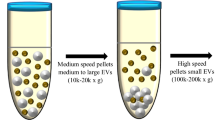Abstract
Growing attention is drawn toward the role of extracellular vesicles (EVs) in infectious diseases. EVs, which are small vesicles released by cells, are involved in cellular communication, immune regulation, and pathogenesis. EVs act as messenger carrying functional cargoes, including RNA, DNA, lipids and proteins from a donor cell to regulate the function of a recipient cell. In malaria, EVs play a key role in regulating the progression from the blood to the transmission stage by promoting the switch between asexual and sexual stages that are taken up by mosquitoes. In addition to their role in parasite communication, EVs modulate the immune system and regulate endothelial cell function.
In this chapter, we describe protocols to isolate, purify and characterize EVs derived from Plasmodium falciparum infected red blood cell culture.
Access this chapter
Tax calculation will be finalised at checkout
Purchases are for personal use only
Similar content being viewed by others
References
Miller LH, Baruch DI, Marsh K, Doumbo OK (2002) The pathogenic basis of malaria. Nature 415(6872):673–679. doi:10.1038/415673a
WHO (2012) WHO Malaria Report 2012
Schofield L, Grau GE (2005) Immunological processes in malaria pathogenesis. Nat Rev Immunol 5(9):722–735. doi:10.1038/nri1686
Mantel PY, Marti M (2014) The role of extracellular vesicles in Plasmodium and other protozoan parasites. Cell Microbiol 16(3):344–354. doi:10.1111/cmi.12259
Nantakomol D, Dondorp AM, Krudsood S, Udomsangpetch R, Pattanapanyasat K, Combes V, Grau GE, White NJ, Viriyavejakul P, Day NP, Chotivanich K (2011) Circulating red cell-derived microparticles in human malaria. J Infect Dis 203(5):700–706. doi:10.1093/infdis/jiq104
Pankoui Mfonkeu JB, Gouado I, Fotso Kuate H, Zambou O, Amvam Zollo PH, Grau GE, Combes V (2010) Elevated cell-specific microparticles are a biological marker for cerebral dysfunctions in human severe malaria. PLoS One 5(10):e13415. doi:10.1371/journal.pone.0013415
Combes V, Coltel N, Alibert M, van Eck M, Raymond C, Juhan-Vague I, Grau GE, Chimini G (2005) ABCA1 gene deletion protects against cerebral malaria: potential pathogenic role of microparticles in neuropathology. Am J Pathol 166(1):295–302. doi:10.1016/S0002-9440(10)62253-5
Couper KN, Barnes T, Hafalla JC, Combes V, Ryffel B, Secher T, Grau GE, Riley EM, de Souza JB (2010) Parasite-derived plasma microparticles contribute significantly to malaria infection-induced inflammation through potent macrophage stimulation. PLoS Pathog 6(1):e1000744. doi:10.1371/journal.ppat.1000744
Mantel PY, Hoang AN, Goldowitz I, Potashnikova D, Hamza B, Vorobjev I, Ghiran I, Toner M, Irimia D, Ivanov AR, Barteneva N, Marti M (2013) Malaria-infected erythrocyte-derived microvesicles mediate cellular communication within the parasite population and with the host immune system. Cell Host Microbe 13(5):521–534. doi:10.1016/j.chom.2013.04.009
Pelle KG, Ahouidi AD, Mantel PY (2013) Role of microvesicles in malaria infections. Med Sci 29(11):960–962. doi:10.1051/medsci/20132911010
Ankarklev J, Brancucci NM, Goldowitz I, Mantel PY, Marti M (2014) Sex: how malaria parasites get turned on. Curr Biol 24(9):R368–R370. doi:10.1016/j.cub.2014.03.046
Regev-Rudzki N, Wilson DW, Carvalho TG, Sisquella X, Coleman BM, Rug M, Bursac D, Angrisano F, Gee M, Hill AF, Baum J, Cowman AF (2013) Cell-cell communication between malaria-infected red blood cells via exosome-like vesicles. Cell 153(5):1120–1133. doi:10.1016/j.cell.2013.04.029
Mantel PY, Hjelmqvist D, Walch M, Kharoubi-Hess S, Nilsson S, Ravel D, Ribeiro M, Grüring C, Ma S, Padmanabhan P, Trachtenberg AJ, Ankarklev J, Brancucci NM, Huttenhower C, Duraisingh MT, Ghiran I, Kuo WP, Filgueira L, Martinelli R, Marti M (2016) Infected erythrocyte-derived extracellular vesicles alter vascular function via regulatory Ago2-miRNA complexes in malaria. Nat Commun 7:12727
Horowitz A, Riley EM (2013) Activation of human NK cells by Plasmodium-infected red blood cells. Methods Mol Biol 923:447–464. doi:10.1007/978-1-62703-026-7_31
Arroyo JD, Chevillet JR, Kroh EM, Ruf IK, Pritchard CC, Gibson DF, Mitchell PS, Bennett CF, Pogosova-Agadjanyan EL, Stirewalt DL, Tait JF, Tewari M (2011) Argonaute2 complexes carry a population of circulating microRNAs independent of vesicles in human plasma. Proc Natl Acad Sci U S A 108(12):5003–5008. doi:10.1073/pnas.1019055108
Acknowledgments
This work was supported by grants from the Novartis Foundation for Medical-Biological Research, from the Research Pool and Fund of the University of Fribourg, as well as from the Gottfried and Julia Bangerter-Rhyner foundation (to M.W. and P.Y.M.).
Author information
Authors and Affiliations
Corresponding author
Editor information
Editors and Affiliations
Rights and permissions
Copyright information
© 2017 Springer Science+Business Media LLC
About this protocol
Cite this protocol
Mbagwu, S., Walch, M., Filgueira, L., Mantel, PY. (2017). Production and Characterization of Extracellular Vesicles in Malaria. In: Kuo, W., Jia, S. (eds) Extracellular Vesicles. Methods in Molecular Biology, vol 1660. Humana Press, New York, NY. https://doi.org/10.1007/978-1-4939-7253-1_31
Download citation
DOI: https://doi.org/10.1007/978-1-4939-7253-1_31
Published:
Publisher Name: Humana Press, New York, NY
Print ISBN: 978-1-4939-7251-7
Online ISBN: 978-1-4939-7253-1
eBook Packages: Springer Protocols




